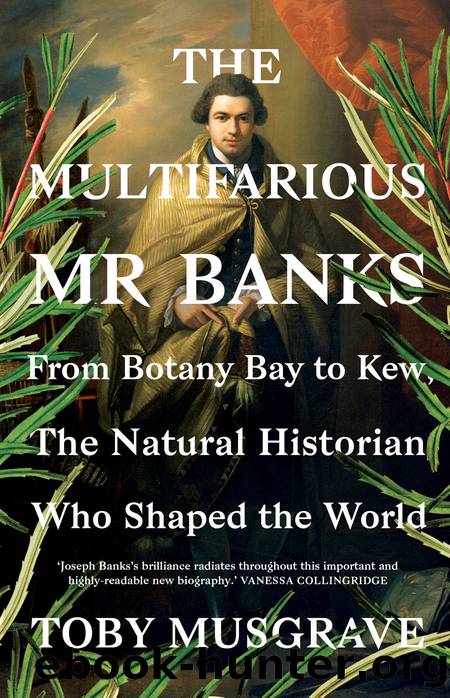The Multifarious Mr. Banks by Toby Musgrave

Author:Toby Musgrave
Language: eng
Format: epub
ISBN: 9780300223835
Publisher: Yale University Press
II
A NEW ACQUISITIONS PARADIGM
To gather together the broadest diversity of living plants required that Banks devise and implement an active and organised acquisitions policy to replace Bute’s somewhat haphazard approach.
GENEROUS DONORS AND PERSONAL PATRONAGE
Banks could and did rely on generous, informal donations made by his extensive network of correspondents, contacts and friends (be they dedicated scientists or amateur botanising ladies and gentlemen). The general rule of thumb was that dried specimens went into Banks’s private herbarium, while live specimens and seed went to Kew. Examples of this type of accession include the nearly 800 taxa of mostly North American trees and shrubs planted in 1773 that found their way to Kew, at least in large part, through the intercession of Dr Fothergill, who enlisted the help of John Bartram on Banks’s behalf. About the same time the Scottish explorer James Bruce (1730–94), who was in Africa endeavouring to discover the source of the River Nile, sent packets of seed to Kew, mostly from Abyssinia. Upon his return and at the request of the artist Zoffany, Banks obtained customs exemption on Bruce’s forty volumes of illustrations. The two men were friendly but very different, as James Boswell delightfully put it: ‘All extraordinary travellers are a kind of shows; a kind of wild beasts. Banks and Bruce however were animals very different one from another. Banks was an elephant, quite placid and gentle, allowing you to get upon his back or play with his proboscis; Bruce, a tiger that growled whenever you approached him.’21
Another donor was Hinton East (d. 1792), plantation owner, eminent botanical collector and active member of the administration at Jamaica, who sent several large donations; while Sir John Murray (c. 1769–1827) dispatched packets of seeds from India where he was on active military service between 1801 and 1805. Banks was also willing to spend his own money, for example in the case of William Brass (d. 1783), a gardener to the first duke of Northumberland who set sail in May 1780 for Cape Coast Castle on the Gold Coast (today’s Ghana). With an annual salary of £130, he was plant hunting for a syndicate that included Northumberland, Banks, Dr Fothergill and the nurseryman James Lee. A small secretarial post had been secured for Brass with the HEIC but working to collect in difficult circumstances and tough conditions he seems to have been all but abandoned by his patrons. Before leaving for home in 1783 – he sadly died on the voyage – Brass sent seed of forty-two taxa and herbarium specimens back to Lee and Fothergill respectively (the latter went to Banks upon Fothergill’s death), as well as botanical drawings which were loaned to Adam Afzelius (1750–1837), yet another Swedish botanist and student of Linnaeus, and subsequently lost.
Afzelius is a good example of Banks’s assiduous cultivation of an often overlapping network of beneficial relationships with individuals and institutions. He was in London in 1791 when Banks was consulted by the politician, philanthropist and leading abolitionist William Wilberforce in his capacity as subscriber to and driving force behind the Sierra Leone Company (SLC).
Download
This site does not store any files on its server. We only index and link to content provided by other sites. Please contact the content providers to delete copyright contents if any and email us, we'll remove relevant links or contents immediately.
Hit Refresh by Satya Nadella(8331)
The Girl Without a Voice by Casey Watson(7260)
When Breath Becomes Air by Paul Kalanithi(7256)
Do No Harm Stories of Life, Death and Brain Surgery by Henry Marsh(6333)
A Court of Wings and Ruin by Sarah J. Maas(6058)
Hunger by Roxane Gay(4210)
Shoe Dog by Phil Knight(4157)
Everything Happens for a Reason by Kate Bowler(4063)
A Higher Loyalty: Truth, Lies, and Leadership by James Comey(4028)
The Rules Do Not Apply by Ariel Levy(3899)
Tuesdays with Morrie by Mitch Albom(3830)
The Immortal Life of Henrietta Lacks by Rebecca Skloot(3821)
How to Change Your Mind by Michael Pollan(3670)
Millionaire: The Philanderer, Gambler, and Duelist Who Invented Modern Finance by Janet Gleeson(3566)
All Creatures Great and Small by James Herriot(3509)
Elon Musk by Ashlee Vance(3451)
Tokyo Vice: An American Reporter on the Police Beat in Japan by Jake Adelstein(3436)
Man and His Symbols by Carl Gustav Jung(3310)
The Money Culture by Michael Lewis(3278)
